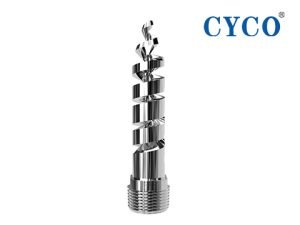Attachment: a selection case of chemical production line
In industrial production, ceramic nozzles are widely used in various fields as an important fluid conveying element. However, different areas and scenarios require different types of ceramic nozzles to meet specific requirements. To ensure safety and efficiency in the production process, it is very important to select the correct model.
Details of ceramic nozzle selection methods and cautions will be introduced in this article.

Types of ceramic nozzles
Ceramic nozzles are mainly divided into solid nozzles, hollow nozzles, adjustable nozzles and porous nozzles according to the use and structure. Different types of nozzles have their own unique characteristics and applicable occasions.
Solid nozzle: good abrasion resistance, suitable for high pressure cleaning, cooling and humidification.
Hollow nozzle: mostly used for occasions requiring variable flow, such as papermaking, printing and dyeing and ceramics industries.
Adjustable nozzle: the spraying angle and flow rate can be adjusted for various occasions where the spraying effect needs to be adjusted.
Porous nozzle: suitable for large-scale spray drying and cooling with a wide spray angle.
Key points for selection
There are several points to consider when selecting a ceramic nozzle:
1. Characteristics of fluids
Properties of the fluid such as viscosity, density, pressure are the basic elements of selection. Choosing the right material and construction of the nozzle according to the nature of the fluid will ensure favorable spraying results and service life.
2. Effects of spraying
Different spray effects require different nozzle structures. For example, a porous nozzle should be selected when a uniform spray is required, and when high pressure cleaning needs to be achieved, a solid nozzle should be selected.
3. Corrosion resistance
Depending on the environment of use, the corrosion resistance of the nozzle needs to be considered. For example, corrosion-resistant materials such as stainless steel or polymer materials should be selected for corrosive environments.
4. Flow and pressure range
In some cases, it may be necessary to select an adjustable nozzle to meet different flow and pressure requirements.
5. Installation and maintenance
The difficulties of installing and maintaining ceramic nozzles needs to be considered when selecting them. For example, when nozzles need to be replaced or cleaned frequently, choose a nozzle design that is easy to remove and replace.

Case of selection
Take the spray drying process of a chemical production line as an example to introduce the selection process of ceramic nozzles.
1. Operating environment: the line involves spray drying of various chemical raw materials, including corrosive gases and dusts, and requires a high level of equipment and components.
2. Effects of spraying: even particles and no residual water pooling are required, so porous ceramic nozzles need to be selected.
3. Characteristics of fluids: considering the viscosity and corrosiveness of the used chemical raw materials, nozzles made of polymer materials were chosen.
4. Flow and pressure range: according to the requirements of the production process, adjustable ceramic nozzles with adjustable flow and pressure were selected.
5. Installation and maintenance: an easily dismantled structural form has been chosen to facilitate nozzle replacement and cleaning maintenance.
Through the above process of selection, we chose a suitable ceramic nozzle for this chemical production line, and achieved favorable results and service life.
Conclusion
Ceramic nozzle as an important fluid conveying element, the correct selection is the key to ensure its safety and efficiency. The article introduces the types of ceramic nozzles and selection points in detail, and illustrated by actual cases.
When selecting ceramic nozzles, it is necessary to consider the above mentioned factors to ensure that the selected ceramic nozzles can meet the specific requirements, so as to provide a reliable guarantee for industrial production.






